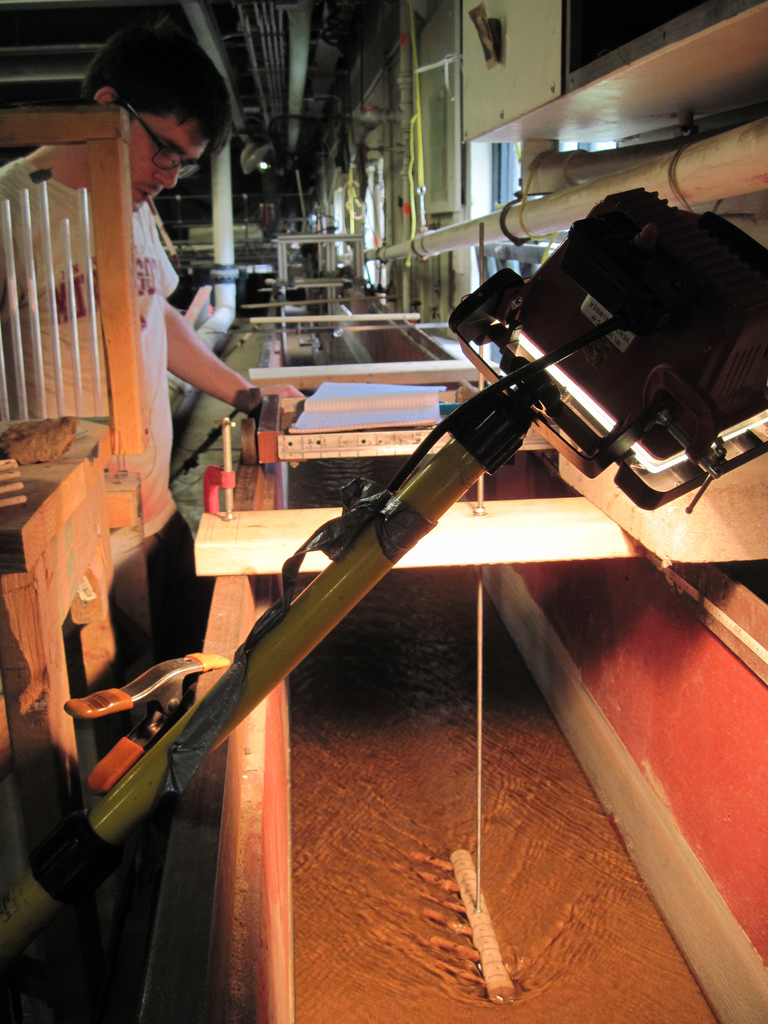To Apply: Visit the REU Blog
This REU introduces undergraduate students to interdisciplinary research on sustainable land and water resources that is essential for improving management practices. Students will work on one of three teams using an interdisciplinary team-oriented approach that emphasizes quantitative and predictive methods. Student projects will integrate the Earth-surface dynamics, geology, ecology, limnology and paleolimnology, and hydrology principles and techniques required for sustainable land and water management and restoration.
Program dates: June - August, 2016
Please send any questions to dianad@umn.edu
Teams: University of Minnesota: Stream restoration-related experimental work; physics of landslides, sustainable cities; Salish Kootenai College, Montana: Community based research on natural resources; Fond du Lac Reservation in northern Minnesota: Paleolimnology and current habitat conditions of wild rice lakes; effects of methyl-mercury on streams. An All-Team Gathering at the conclusion of the program will bring all teams together to celebrate their summer research in a research symposium, with talking circles to discuss research in a community context, and hands-on experiments in St. Anthony Falls Laboratory facilities.
The program is open to undergraduate students majoring in civil engineering, geosciences, ecology, mathematics, or related fields. We encourage applications from students who have been historically under-represented in their discipline and from first-generation college students. The program provides transportation, food, and housing plus a stipend to all participants.
Team Stream will focus on issues of sediment transport related to stream and delta restoration problems using state of the art facilities at SAFL tied with field studies in nearby stream restoration sites. Studies will be conducted in SAFL's flumes and in the Outdoor Stream Laboratory. Examples of research projects include: (1) Gravel patches in rivers. Particles tend to self-segregate according to particle properties (such as size and density) leading to what are often dramatic examples of pattern formation. One of many examples involves the formation and evolution of gravel patches along a river bed: Along a river that is typically transporting a wide distribution of particle sizes, relatively narrowly distributed patches of gravel may form along a river bed. The patches both influence the transport of gravel and provide spawning grounds for certain fish species. There is no predictive formulation for these patches. This project will focus on formation of gravel patches under different conditions including flow conditions and sediment supply. (2) Bank stability in the presence of an infusion of fines. Under flood conditions, rivers are subjected to extra shear stress due to the extra flow of water. They are inundated with additional particles, usually much finer than those present in the river. This project will focus on experimental studies of the particle size ratio over which this is a significant issue for stream restoration projects and field studies to determine where these ratios will occur in local stream restoration projects. (3) Infiltration of fines into a gravel bed. When small sized particles of diameter df are introduced onto base of larger sized particles of diameter dc, if they are sufficiently small they can travel into the pore spaces and clog them, a process called infiltration. This can critically affect fish habitat as it reduces the flow of oxygen, nutrients, and waste.
Team SPAW will conduct research throughout the Salish and Pend d’Oreille Aboriginal Watershed (SPAW) in western Montana. This research will examine the effects of various land and water use, practices, and management on local and regional communities with emphases on sustainability, economic development, and resource and cultural protection. These projects historically involve: examinations of how surface water management influences groundwater supplies; parasite monitoring in amphibians and reptiles; environmental monitoring; protection, and restoration of culturally significant plant species stressed by anthropogenic and natural disturbances; river restoration activities; chemical monitoring and analyses of SPAW water systems including C, N, Hg, As, and others. Each student on Team SPAW will conduct his or her own research project, which will be a subset of the overall research. These student projects will be tailored from the broader topic of surface water-groundwater interactions to fit a specific student's area of interest. These individual projects are selected to best match project and student needs and may require sharing of many skillsets including: representation and manipulation of survey data in a GIS program, laboratory and equipment operational experience, computational statistics and modeling, mapping and surveying and more. Students may participate in multiple ongoing collaborative research projects with the Confederated Salish and Kootenai Tribes and Salish and Kootenai College that encompass physical, chemical, biological, and social perspectives.
Team Gida’s research projects were developed in a partnership between Fond du Lac Tribal and Community College, the University of Minnesota, and Fond du Lac Resource (FDL) Management, based on the community need to understand the past, present, and future conditions of wild rice (manoomin). Interns in this project will conduct research using core samples and modern measurements from wild rice lakes. We use an interdisciplinary approach that includes geophysical profiling, remote sensing and visualization, and historical research, to understand past conditions for wild rice growth, current challenges for restoring and enhancing its habitat, and effective management for future production. These efforts complement FDL Resource Management’s long term lake sampling and monitoring program. Students will conduct research in the field and laboratory on the Fond du Lac (Nagajiiwanaang) Reservation in northern Minnesota, as well as at the facilities of LacCore on the campus of the University of Minnesota in Minneapolis. Examples of research projects include: identifying plant remains to reconstruct ecological communities of the past; extracting phytoliths to learn where wild rice has grown and how long it has been in these lakes; analysis of fossil diatoms to understand past habitats and lake depth; measurement of phosphorus and other elements and nutrients in the sediments; GIS analysis and mapping of core locations and characteristics; collecting plants from the lake area and curation of samples at the FDLTCC herbarium; water quality monitoring; collecting additional core samples; and more.
Dr. Diana Dalbotten
